How and how to glue the veneer?
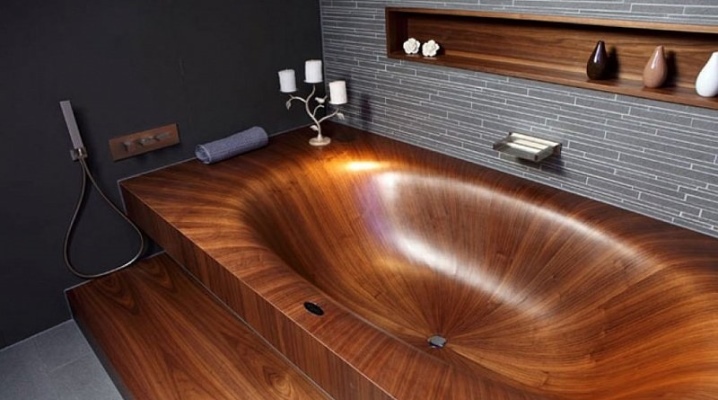
Natural wood veneer retains the grain of the wood and allows you to update or decorate the surfaces of furniture, door leaves, countertops, cornices, wall panels.
You can extend the service life of a veneered product if you re-glue the veneer onto its surface with your own hands.
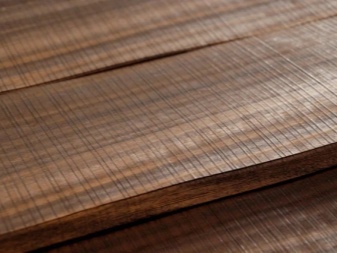
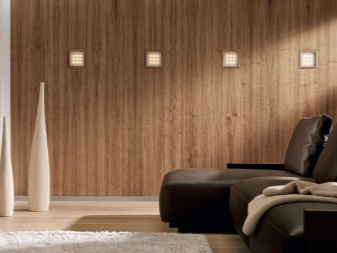
Adhesive selection
For veneering wooden surfaces, it is necessary to select an adhesive composition. The success of the work depends on the correct choice of glue. Experts believe that it is best for veneers to choose compositions whose principle of action is that organic solvents evaporate during the polymerization process, and the polymer component that is part of the glue ensures reliable adhesion of the material to the surface to be coated.
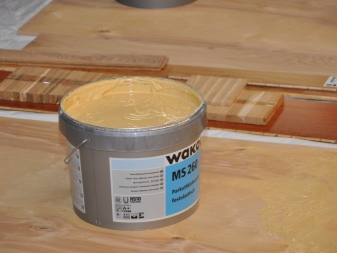
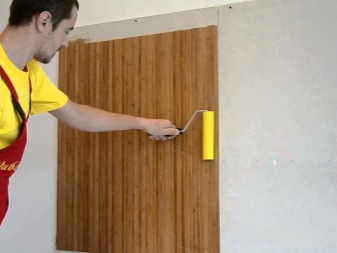
Views
The following types of glue are used for gluing veneer.
- Polyvinyl acetate (PVA) glue. It is an aqueous emulsion of a polyvinyl acetate component with the addition of plasticizing components. On PVA, veneer is glued for facing surfaces ideally aligned in structure. To perform the bonding, use the hot lapping method, performed with a heated iron. The PVA adhesive composition has no harmful components and does not pose a threat to human health. The adhesive mass is easy to apply and spread over the surface of the material and guarantees good adhesion.
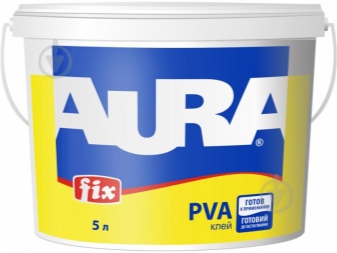
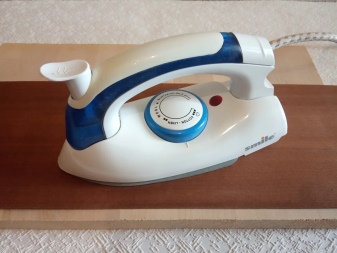
- Joiner's glue. It can be cat or flesh, on sale it is found in the form of powder or granules, which must be steamed with boiling water. Wood gluing is done with hot glue. When added to the composition of glycerin, the adhesive mass increases its resistance to high temperatures. Wood glue has a very strong adhesive capacity and is used for gluing large veneer sheets.
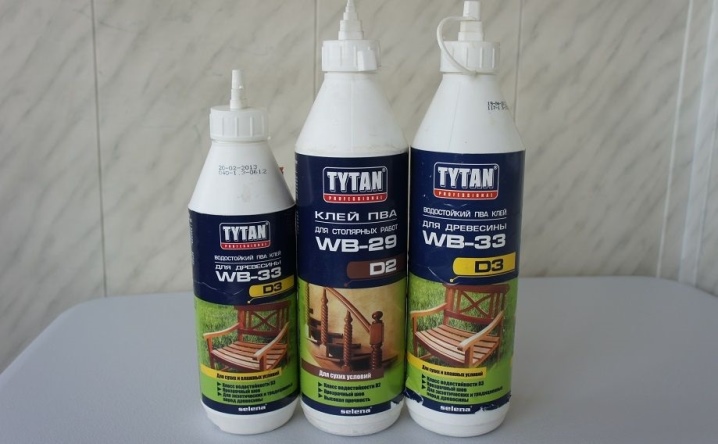
- Polyurethane glue. Belongs to the class of polymeric synthetic compounds, which are characterized by film formation. Has a high degree of resistance to acids, oils, alkalis, gasoline and so on. It can be used for gluing wood veneer, as it has a high degree of adhesion when used correctly.

- Wood glue. It is a ready-made adhesive for gluing wood-based materials. Each manufacturer has its own patented formula, which has a certain set of characteristics.

- Epoxy resin. In some cases, a two-component resin can be used to glue the veneer. This composition has a high degree of viscosity and excellent adhesive properties, it polymerizes quickly and forms a monolithic bond of two materials.

Before using this or that type of glue, you must familiarize yourself with its composition and take into account the specifics of its application. For porous wood veneer, it is necessary to choose viscous and thick adhesive compositions with good adhesion.
Popular manufacturers
The choice of the brand of glue depends on the thickness of the veneer and the area of the working surface to be veneered. Small parts can be glued with a thick PVA composition. For more voluminous work, you will need to choose specialized professional tools.
- Moment Classic glue from the Henkel producer. This is a universal type of adhesive that quickly and reliably glues any surface texture, including wood. The glue contains formaldehydes, rubber, rosin resin, acetone, polymer additives and other components. The glue of this brand has fast adhesive ability, resistance to moisture and high temperature conditions, as well as a high degree of plasticity.
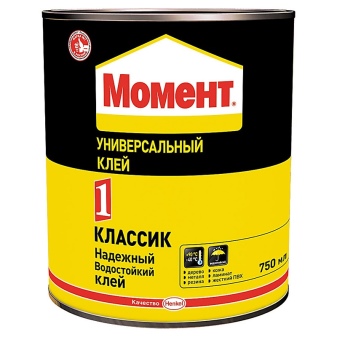

- Kleiberit adhesive from KLEBCHEMIE M. G. Becker GmbH & Co. KG. The brands of glue have different variations. Glue 300.0 contains PVA dispersion. It is suitable for working with wood-based materials, while forming a transparent adhesive layer. Adhesion of the glue is carried out at room temperature for 10 minutes. Glue 332.0 also has an aqueous dispersion of PVA in its composition, has a medium viscosity and allows you to work with it at room temperature. The adhesion time is 20 minutes. Glue 501.0 is a foaming one-component polyurethane compound designed for working with wood. It can be used for working with curved profile products. Curing time is 60 minutes at room temperature.
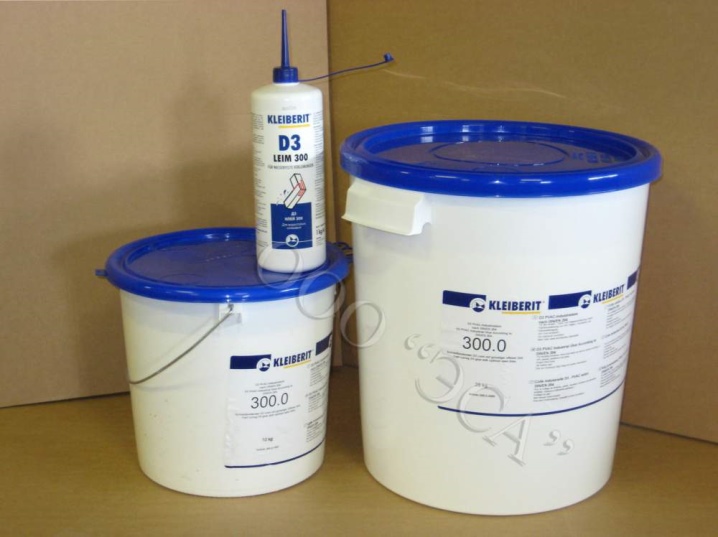
- DUDITERM adhesive from Durante & Vivan S. p. A. Grade 715 is a low viscosity polymer formulation with a long cure time prior to adhesion. Designed for veneering wood surfaces and for gluing edges. Grade 848 is a powdered glue containing formaldehyde and urea. It is used for gluing single-layer plywood and veneer to chipboards. For polymerization, it is necessary to use hot pressing.

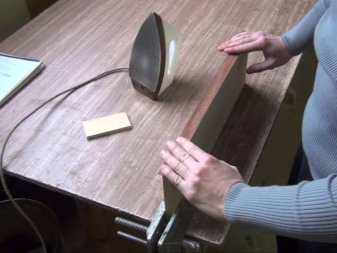
- UHU HOLZ glue from the manufacturer GmbH, Bul (Baden), Germany. The adhesive has a viscous white structure, which becomes transparent after polymerization. Adhesion occurs due to the swelling of the wood fibers. The adhesive bond is highly durable, resistant to mechanical stress and the action of chemical components. Dissolves with acetone and nitro solvent.
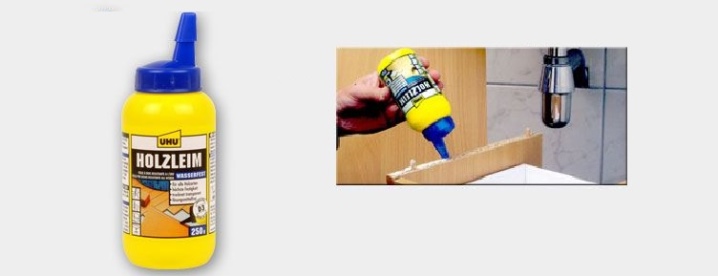
Currently, the choice of adhesives from various manufacturers is very diverse. You can buy glue for working with wood at any hardware store.
How to prepare the surface and material?
To perform veneering, it is necessary to prepare the material for work. The purchased veneer will need to be aligned. To do this, the roll is rolled out on a horizontal surface, moistened with a paint brush and placed under a press for several days until it dries completely.
The next step is cutting the sheet. The blank for veneering must be measured. The resulting dimensions are applied to a veneer sheet, in addition, from each edge, add 50 mm for allowances, which will help with inaccurate measurements. After marking, the material must be cut using a special plunge-cut saw or a plywood knife. Scissors are not used for cutting, as cracking of the material may appear. If the veneer is made in the form of stripes, it is necessary to select them in such a way that the wood pattern fits nicely.
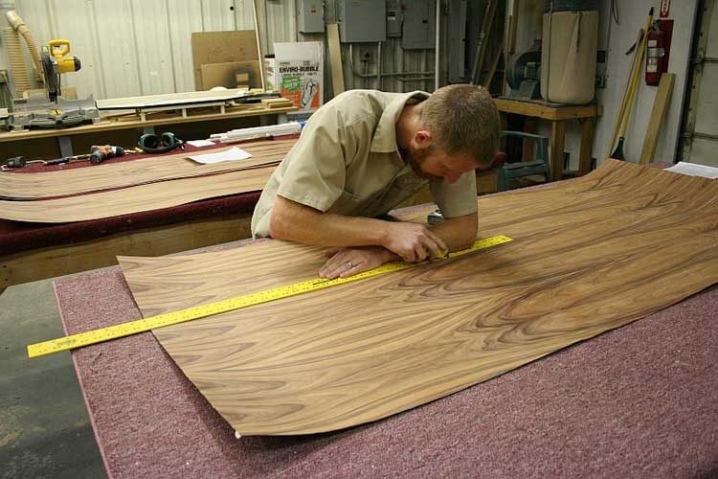
The surface, which will be subject to the gluing of the veneer, must also be prepared for work.
If you want to update the door leaf, you must remove all fittings and decorative elements from it. Besides, it will be necessary to remove the old decorative coating from the wooden surface with a sharp metal spatula. To facilitate such stripping, the spatula is heated or a blow dryer is used. When the surface is cleaned, it is carefully examined for the presence of pits, chips, scratches - all these defects must be eliminated using wood putty. After the putty dries, the wooden base must be cleaned with sandpaper and a sander.The last preparatory step before veneering is to degrease the wood surface with acetone or industrial alcohol.
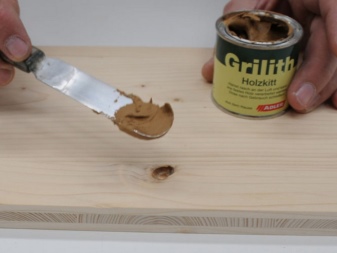
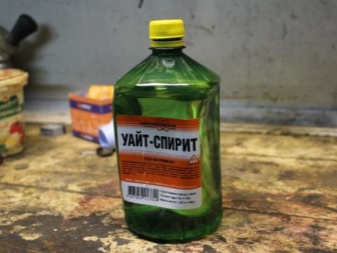
Gluing methods
Pasting a wooden surface with veneer is quite feasible at home. To follow this procedure correctly, check out several ways to glue veneer to MDF.
Cold pin
The material can be glued onto a straight or curved surface. The technique involves the use of an adhesive composition with a short polymerization period. The gluing of parts with such adhesives is quick, therefore, to work with large surfaces, it is necessary to perform the procedure with an assistant. Since the veneer will set very quickly to the base, veneering must be done with great care and accuracy, because it will no longer be possible to correct the errors. A prerequisite for gluing the material is to ensure that the veneer is pressed during installation. The contact method is time consuming, therefore it is used on workpieces small in area.
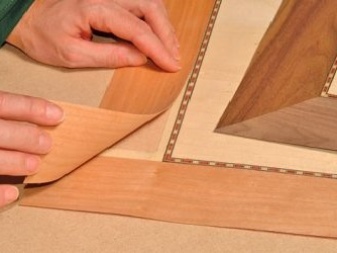
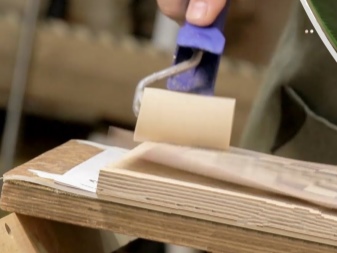
Hot
The technique involves the use of a viscous adhesive composition, which is applied to the working plane of a wooden surface. After application, the glue should stand a little and dry, after which a veneer is applied to the workpiece. Next, the veneer is smoothed over the surface of the workpiece with a hot iron, moving from the center to the edges. The high temperature melts the adhesive and provides strong and uniform adhesion.
In this way, it is possible to glue the veneer on an uneven surface, provided that such unevenness is insignificant - this difference can be leveled under a layer of glue.
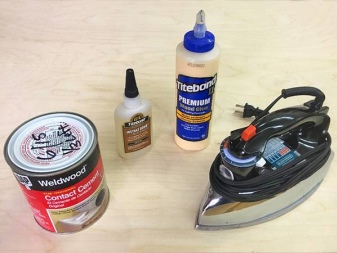

Cold pressed
The essence of the technique is that glue is applied to the surface of the workpiece, and then the veneer is glued. To dry the glue, the workpiece is placed under a press and kept there until the glue is completely dry. Plywood sheets and carpentry clamps are used as a clamping device. It is better to use this method on small-sized workpieces.
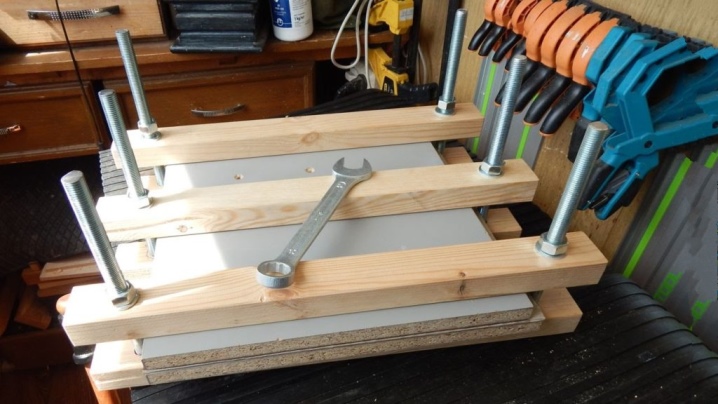
The listed methods of veneering are reliable and do not require special expensive fixtures or professional skills.
Possible mistakes
The most common defects in veneering are as follows.
- Leakage of glue through the pores of the wood onto the surface of the product - this can happen if you choose too liquid glue for work. If the glue has a reversible composition, then the veneered surface is moistened with water, covered with paper and passed with a hot iron. If the veneer is made with irreversible glue, it cannot be removed.
- Partial material delamination occurs when the glue is applied unevenly. The defect is eliminated by gluing by applying glue under the veneer section raised with a spatula. After gluing, the part is again dried under a press.
- Bubbles under the veneer. The reason for their appearance is insufficiently good smearing of working surfaces with glue or grease contamination on the workpiece. If you cut the bubble much along the grain of the pattern and introduce glue, and then iron this area, then the problem can be eliminated.


Most mistakes can be avoided if the workpiece is prepared as carefully as possible before veneering, and when applying the adhesive, do not save money, but carefully coat the entire working surface.
Recommendations
If, after veneering, cracks appear on the surface of the material, this means that the workpiece was not sufficiently dried. In order not to get into such a situation, it is recommended to take into work only well-dried workpieces. In addition, when gluing the veneer, it is best to position the direction of its fibers in the same way as they are located on the workpiece.
In some cases, when gluing veneer strips together, after the material has dried, divergences of these strips may form. The reason for this problem also lies in the fact that the workpiece has not been thoroughly dried. To correct the defect, veneer inserts, matched to the pattern and matching in texture, will help.
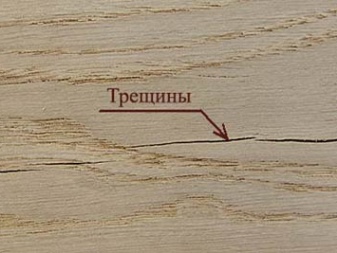

For tips on gluing veneers, see below.













The comment was sent successfully.